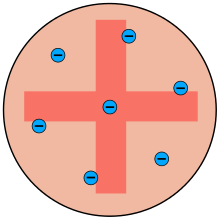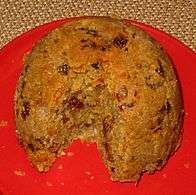Plum pudding model



The plum pudding model is an obsolete scientific model of the atom proposed by J. J. Thomson in 1904.[1] It was devised shortly after the discovery of the electron but before the discovery of the atomic nucleus.
In this model, the atom is composed of electrons (which Thomson still called "corpuscles", though G. J. Stoney had proposed that atoms of electricity be called "electrons", in 1894[2]) surrounded by a soup of positive charge to balance the electrons' negative charges, like negatively charged "plums" surrounded by positively charged "pudding". The electrons (as we know them today) were thought to be positioned throughout the atom, but with many structures possible for positioning multiple electrons, particularly rotating rings of electrons (see below). Instead of a soup, the atom was also sometimes said to have had a "cloud" of positive charge. With this model, Thomson abandoned his earlier "nebular atom" hypothesis in which the atom was composed of immaterial vortices. Now, at least part of the atom was to be composed of Thomson's particulate negative "corpuscles", although the rest of the positively charged part of the atom remained somewhat nebulous and ill-defined.
The 1904 Thomson model was disproved by the 1909 gold foil experiment of Hans Geiger and Ernest Marsden. This was interpreted by Ernest Rutherford in 1911[3] [4] to imply a very small nucleus of the atom containing a very high positive charge (in the case of gold, enough to balance about 100 electrons), thus leading to the Rutherford model of the atom. Although gold has an atomic number of 79, immediately after Rutherford's paper appeared in 1911 Antonius Van den Broek made the intuitive suggestion that atomic number is nuclear charge. The matter required experiment to decide. Henry Moseley's work showed experimentally in 1913 (see Moseley's law) that the effective nuclear charge was very close to the atomic number (Moseley found only one unit difference), and Moseley referenced only the papers of Van den Broek and Rutherford. This work culminated in the solar-system-like (but quantum-limited) Bohr model of the atom in the same year, in which a nucleus containing an atomic number of positive charge is surrounded by an equal number of electrons in orbital shells. Bohr had also inspired Moseley's work.
Thomson's model was compared (though not by Thomson) to a British dessert called plum pudding, hence the name. Thomson's paper was published in the March 1904 edition of the Philosophical Magazine, the leading British science journal of the day. In Thomson's view:
... the atoms of the elements consist of a number of negatively electrified corpuscles enclosed in a sphere of uniform positive electrification, ...[5]
In this model, the electrons were free to rotate within the blob or cloud of positive substance. These orbits were stabilized in the model by the fact that when an electron moved farther from the centre of the positive cloud, it felt a larger net positive inward force, because there was more material of opposite charge, inside its orbit (see Gauss's law). In Thomson's model, electrons were free to rotate in rings which were further stabilized by interactions between the electrons, and spectra were to be accounted for by energy differences of different ring orbits. Thomson attempted to make his model account for some of the major spectral lines known for some elements, but was not notably successful at this. Still, Thomson's model (along with a similar Saturnian ring model for atomic electrons, also put forward in 1904 by Nagaoka after James Clerk Maxwell's model of Saturn's rings), were earlier harbingers of the later and more successful solar-system-like Bohr model of the atom.
Related scientific problems
The plum pudding model with a single electron was used in part by the physicist Arthur Erich Haas in 1910 to estimate the numerical value of Planck's constant and the Bohr radius of hydrogen atoms. Haas' work estimated these values to within an order of magnitude and preceded the work of Niels Bohr by three years. Of note, the Bohr model itself only provides substantially-reasonable predictions for atomic and ionic systems having a single effective electron.
A particularly useful mathematics problem related to the plum pudding model is the optimal distribution of equal point charges on a unit sphere called the Thomson problem. The Thomson problem is a natural consequence of the plum pudding model in the absence of its uniform positive background charge.[6]
The classical electrostatic treatment of electrons confined to spherical quantum dots is also similar to their treatment in the plum pudding model.[7][8] In this classical problem, the quantum dot is modeled as a simple dielectric sphere (in place of a uniform, positively-charged sphere as in the plum pudding model) in which free, or excess, electrons reside. The electrostatic N-electron configurations are found to be exceptionally close to solutions found in the Thomson problem with electrons residing at the same radius within the dielectric sphere. Notably, the plotted distribution of geometry-dependent energetics has been shown to bear a remarkable resemblance to the distribution of anticipated electron orbitals in natural atoms as arranged on the periodic table of elements.[9] Of great interest, solutions of the Thomson problem exhibit this corresponding energy distribution by comparing the energy of each N-electron solution with the energy of its neighbouring (N-1)-electron solution with one charge at the origin. However, when treated within a dielectric sphere model, the features of the distribution are much more pronounced and provide greater fidelity with respect to electron orbital arrangements in real atoms.[10]
References
- ↑ "Plum Pudding Model - Universe Today". Universe Today. 27 August 2009. Retrieved 19 December 2015.
- ↑ G. J. Stoney, (1894). "Of the "Electron" or Atom of Electricity" (non math extract of paper). Philosophical Magazine, Series 5 38 (233): 418–420. doi:10.1080/14786449408620653.
- ↑ Joseph A. Angelo (2004). "Nuclear Technology". Greenwood Publishing. ISBN 1-57356-336-6.
- ↑ Akhlesh Lakhtakia (Ed.); Salpeter, Edwin E. (1996). "Models and Modelers of Hydrogen". American Journal of Physics (World Scientific) 65 (9): 933. Bibcode:1997AmJPh..65..933L. doi:10.1119/1.18691. ISBN 981-02-2302-1.
- ↑ J.J. Thomson (1904). "On the Structure of the Atom: an Investigation of the Stability and Periods of Oscillation of a number of Corpuscles arranged at equal intervals around the Circumference of a Circle; with Application of the Results to the Theory of Atomic Structure" (extract of paper). Philosophical Magazine Series 6 7 (39): 237–265. doi:10.1080/14786440409463107.
- ↑ Y. Levin and J. J. Arenzon (2003). "Why charges go to the Surface: A generalized Thomson Problem". Europhys. Lett. 63: 415–418. arXiv:cond-mat/0302524. Bibcode:2003EL.....63..415L. doi:10.1209/epl/i2003-00546-1.
- ↑ S. Bednarek, B. Szafran, and J. Adamowski (1999). "Many-electron artificial atoms". Phys. Rev. B 59 (20): 13036–13042. Bibcode:1999PhRvB..5913036B. doi:10.1103/PhysRevB.59.13036.
- ↑ T. LaFave Jr (2013). "Correspondences between the classical electrostatic Thomson problem and atomic electronic structure". J. Electrostatics 71 (6): 1029–1035. doi:10.1016/j.elstat.2013.10.001.
- ↑ T. LaFave Jr (2013). "Correspondences between the classical electrostatic Thomson problem and atomic electronic structure". J. Electrostatics 71 (6): 1029–1035. doi:10.1016/j.elstat.2013.10.001.
- ↑ T. LaFave Jr (2014). "Discrete transformations in the Thomson Problem". J. Electrostatics 72 (1): 39–43. doi:10.1016/j.elstat.2013.11.007.
| ||||||||||||||||||||||||||